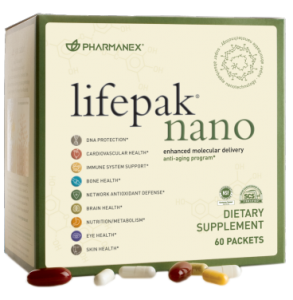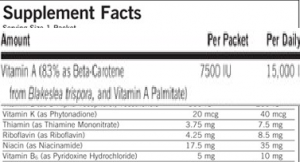Vitamin A Safe in LifePak Products
Vitamin A is highly recommended and needed vitamin that most of us can get from our diet if it is rich in yellow, orange, and dark green vegetables and fruits. With that being said most Americans eat less than 2 servings of these each day so Americans NEED to supplement. But now you must choose a powerful anti-aging full body supplement to get your money’s worth, I chose Pharmanex LifePak- the Nano formulation is the best but their regular formulations are very good also.
Now with regards to Vitamin A on the LifePak Nano, LifePak Women and LifePak Prime label reading is crucial here, don’t let the 15,000 iu give you the impression that there is too much Vitamin A and that hair loss, fatigue or diarrhea could be issues because it is above the 10,000 iu RDA. But the label is a combination of beta-carotene and Vitamin A. Pharmanex is well aware of this but due to FDA labeling laws they must list these ingredients as one. But if you take the time to read the label (see below) it is clearly marked, “combined” listing the Vitamin A AND beta-carotene but the beta-carotene makes up 83% of the projected 15,000 iu so NO over dose of Vitamin A is going on here. You are only getting 1,250 per packet or 2,500 iu of pure Vitamin A in a normal daily dose of LifePak Nano, Women or Prime. The Regular LifePak only has Vitamin A and NO beta-carotene so that label reflects this as 2,500 iu total daily dose when two packets are consumed.
Beta-Carotene Converts to Vitamin A “As Needed”
Now the body will only convert beta-carotene to Vitamin A (Palmitate) in an “on demand” system therefore if the body does not need it there is no conversion. So over dosing on beta-carotene is impossible.
Vitamin A Deficiency
Vitamin A deficiency is rare in developed nations but remains a concern in developing countries, particularly in areas where poor nutrition is common. Prolonged deficiency can lead to xerophthalmia (dry eye) and ultimately to night blindness or total blindness, as well as to skin disorders, infections (such as measles), diarrhea, hair loss and lung disorders.
Vitamin A Toxicity
With special attention to "hair loss" here in the USA due to too much Vitamin A in Pharmanex LifePak products you need not worry. Lifepak cannot cause this mild symptom as the actual dose of straight Vitamin A is actually 2,500 iu and the rest that you see on the label is beta-carotene which the body will not over dose on. SO HAIRLOSS FROM LIFEPAK DUE TO TOO MUCH VITAMIN A IS NOT GONG TO HAPPEN.
Vitamin A is LIKELY SAFE for children when taken in the recommended amounts. The maximum amounts of vitamin A that are safe for children are based on age:
- Less than 2000 units/day in children up to 3 years old.
- Less than 3000 units/day in children ages 4 to 8 years old.
- Less than 5700 units/day in children ages 9 to 13 years old.
- Less than 9300 units/day in children ages 14 to 18 years old.
Vitamin A for Adults
Tolerable Upper Intake Levels (UL) for vitamin A have also been established. The UL is the highest level of intake that is likely to pose no risk of harmful effects.
10,000 units/day for men and women(including pregnant and lactating) 19 years and older
Eating 5 servings of fruits and vegetables per day provides about 50% to 65% of the adult RDA for vitamin A.
Vitaminn A is Currently Used for:
- Breast cancer. Premenopausal women with a family history of breast cancer who consume high levels of vitamin A in their diet seem to have reduced risk of developing breast cancer. It is not known if taking vitamin A supplements has the same benefit.
- Research suggests that high intake of vitamin A in the diet is linked to a lower risk of developing cataracts.
- Diarrhea related to HIV. Taking vitamin A along with conventional medicines seems to decrease the risk of death from diarrhea in HIV-positive children with vitamin A deficiency.
- Taking vitamin A by mouth seems to decrease malaria symptoms in children less than 3 years-old living in areas where malaria is common.
- Taking vitamin A by mouth seems to reduce the risk of measles complications or death in children with measles and vitamin A deficiency.
- Precancerous lesions in the mouth (oral leukoplakia). Research suggests that taking vitamin A can help treat precancerous lesions in the mouth.
- Recovery from laser eye surgery (photoreactive keratectomy). Taking vitamin A by mouth along with vitamin E seems to improve healing after laser eye surgery.
- Complications after pregnancy. Taking vitamin A seems to reduce the risk of diarrhea and fever after pregnancy in malnourished women.
- Complications during pregnancy. Taking vitamin A by mouth seems to reduce the risk of death and night blindness during pregnancy in malnourished women.
- Eye disease affecting the retina (retinitis pigmentosa). Research suggests that taking vitamin A can slow the progression of an eye disease that causes damage to the retina.
Possibly Ineffective for:
- Breathing problems that affect newborns (bronchopulmonary dysplasia). Research shows that injecting vitamin does not reduce the risk of breathing problems in low birth weight infants.
- Gastrointestinal side effects of chemotherapy. Taking vitamin A by mouth does not prevent or reduce gastrointestinal side effects of chemotherapy in children.
- Fetal and early infant death. Taking vitamin A supplements before, during, or after pregnancy does not seem to reduce the risk of fetal or early infant death when taken by malnourished women. However, giving vitamin A to some infants seems to lower the risk of infant death in areas where malnutrition or vitamin A deficiency is common.
- A type of skin cancer called melanoma. Research shows that taking vitamin A by mouth does not increase disease-free survival in people with melanoma.
- Women who take vitamin A by mouth, alone or in combination with other vitamins before or during early pregnancy, do not have a lower risk of miscarriage or stillbirth.
- Taking a specific product containing selenium, vitamin A, vitamin C, and vitamin E (Selenium ACE) does not appear to improve osteoarthritis. Also, taking additional vitamin A does not reduce pain in people with spinal osteoarthritis who have adequate levels of vitamin A.
- Low levels of vitamin A are common in people with tuberculosis. However, taking vitamin A does not appear to improve symptoms or decrease the risk of death in people with tuberculosis.
Likely Ineffective for:
- Head and neck cancer. Taking vitamin A by mouth does not reduce the risk of developing new tumors or improve survival in people with head and neck cancer.
- HIV transmission. Taking vitamin A by mouth does not lower the risk of passing HIV to the fetus during pregnancy, to newborns during delivery, or to infants during breastfeeding. In fact, early research suggests that HIV-positive women who take vitamin A supplements during pregnancy might have an increased risk of passing HIV to their babies through breast milk.
- Lower respiratory tract infections. Taking vitamin A by mouth does not prevent or reduce symptoms of lower respiratory tract infections in children. In fact, vitamin A is linked to a slight increase in the risk of respiratory tract infections in children.
- Taking vitamin A by mouth does not help treat or prevent pneumonia in children living in developing countries.
References (Vitamin A)
WebMD.com
MayoClinic.org


